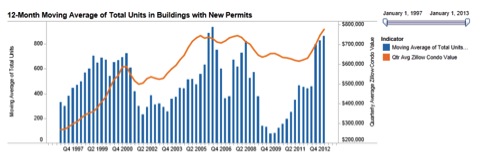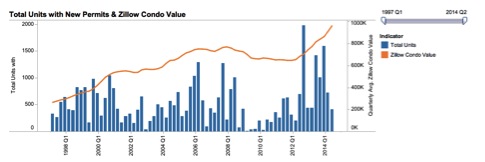Neighbors Using Sketchy Article Against Supply and Demand
Evidently there has been a year old article from San Francisco that has been circulated to members of the Mayor’s Housing Affordability and Livability Agenda (HALA) Committee. The article is called “SF Controller Shows ‘Supply and Demand’ Does Not Work in the San Francisco Housing Market.” Now arguing against and trying to prove that supply and demand have no effect on housing prices is the bedrock ideological starting point for people arguing for increasing housing costs by imposing a tax on new housing. If they can sow that increasing supply won’t help prices, then, they think, they’ll carry the day. So does the article deliver. The ambitiously titled 3 page paper (with derisive quotation marks around supply and demand) falls completely flat.
First of all, the entire paper is based on a chart showing building permits and condo prices and doesn’t include rentals or other types of housing, hardly a comprehensive review of the entire housing market. And the chart appears to show increasing prices for condos even though production is up. Building permits aren’t the best tool to measure production since completion of units lags behind granting permits. And here’s what an actual comprehensive review of housing inventory in San Francisco says about building permits:
If DBI approves the project following its own review, it issues building permits authorizing construction. Projects with approved building permits generally start construction within 90 days from the date the permit is issued. Start of construction, however, may be delayed for up to a year. If the permit is not picked up or acted on within 90 days, the permit expires. The number of units authorized for construction is a key indicator of future housing construction.
Projects are inspected by DBI at various stages throughout the construction process. However, inspectors only issue Certificates of Final Comple- tions (CFCs) for projects that are deemed 100% complete. Units certified complete are an indicator of changes to the City’s housing supply and include units gained or lost from new construction, alterations, and demolitions (emphasis is mine).
Here’s a chart of how it works:
So the chart is reporting just one part of the process and given the length of time between the beginning and certification there is a lag. Here’s the chart:

But when one follows the link in the footnote which leads back to the Controller’s actual website here’s what’s there:

You can see the Zillow line trend up in 2014 as the number of units with new permits drops. I wouldn’t claim that this proves very much of anything, but the chart that the author claims makes and open and shut case for refuting hundreds of years of economics doesn’t include the last two years. Is that because the picture wasn’t as favorable showing an increase in prices when permits dropped? Who knows, but a chart looking at permits and condo prices on Zillow isn’t going to make a decisive case much no matter how you slice it and dice it.
But the author doesn’t just stop with an incomplete graph. He goes on to explain exactly why supply and demand doesn’t work. He makes three points.
First, he blames land owners. “There is no ‘free land’ in San Francisco. The owners have total ‘market power’ over its price.” Because property owners have a monopoly on land they are holding out for more and more money for the land driving up prices. Therefore, no matter how much housing San Francisco builds prices won’t go down. But he just made the case perfectly for supply and demand: land is in demand and there is low supply so it is very expensive. Somehow what applies to land, doesn’t apply to housing units. One could change the sentence so it reads like this, “There is no ‘free housing’ in San Francisco. The owners have total ‘market power’ over its price.” That’s because it’s hard to produce more of it, which is what contributes to higher prices. Density can absorb those costs, with more people sharing the costs of the land, construction, and financing. But if building is over regulated that can’t happen.
The authors second point is a bit confused also. He says that new supply is just that, new. New housing is more expensive. This is exactly what supply deniers always point to when new housing comes on line: see, they say, you built more and prices went up anyway. When you compare the price of new construction to overall housing prices the new construction is more expensive. It’s new! But the author points to the fact that housing price is affected by the sales of existing housing. He says, “any theory of price that ignores half of the sales is bound to be wildly inaccurate.” But that’s exactly what his article does, ignore overall prices over time. All he does is look at new condo prices compared to building permits and declares supply and demand dead. What happened to existing condo prices when more building happened? Did those old condos get cheaper? We don’t know because he didn’t do the work.
Lastly the author offers this:
In a market economy, housing is a commodity like soy beans or pork bellies. Speculation in commodities, driving wild swings in price, is a structural part of the market. Housing speculation in a “hot market” like San Francisco is simply part of the market with powerful impacts on price no matter what new construction is happening.
Wait. I thought it was the land owners holding out for more money that was driving up the prices. The author shifts gears and says is the speculative buyer that is pushing up prices because they have lots and lots of cash. So who’s to blame, the greedy land owner or the greedy speculator? What the author is trying to get at–with zero data to support it–is that something scarce, like land or Napoleon’s hat, gets very pricey. But that is called “supply and demand!” If I am buying something scarce at a high price, my business model requires that it stay scarce or get even more scarce so I can get a return. Over regulation makes sure that people buying land for a high price with cash has a shot at getting their money back and more.
And what is the author’s solution to the problem? His proposal is to expand rent control and “insulate” residents from “the market” by putting more housing into public ownership. There is something to the idea of public ownership. If the City government was to buy lots of the land they could build housing and charge low prices for it. But that would come at a tremendous cost–billions of dollars.
Rather than contorted arguments based on selectively edited charts and graphs the HALA Committee should focus on how we encourage and incentivize more housing production of all types all over the city at prices everyone can afford.



